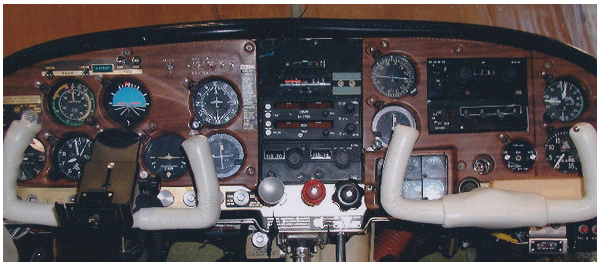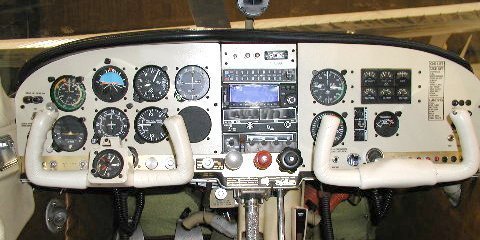Upgrading Pre-1969 Instrument Panels
January 2004
From some viewpoints, owning an airplane is similar to owning a home. It is often better to upgrade rather than buying new. To maximize the return on investment, for a home, arguably putting money into upgrading the kitchen can produce the best return on investment. Upgrading the look, layout and quality of the appliances can greatly add to the efficiency of meal preparation and generally adds to the value of the house. Likewise, upgrading the look, layout and quality of your airplane’s instruments can improve pilot efficiency and increase value. After all, the instrument panel is where most of the work of flight management occurs. With increased efficiency, the pilot’s workload drops; with lowered workload and modern equipment, safety and capability are improved.
Prior to 1969, Mooney Aircraft (and some other brands) came with instrument panels of a non-T configuration. Before 1970, the FAA had no standard layout for the pilot’s instrument panel. It was common to find the altimeter in the far left lower corner, the turn coordinator in the far right corner and the gyros in various other positions. In 1970, through the mandate of FAR 23.1321, the FAA standardized the layout for the pilot’s panel. The gyro horizon is located in the top center position; the airspeed indictor is located immediately to the left with the turn coordinator just below it. Directly under the gyro horizon is the directional gyro and to the immediate right of the horizon is the altimeter. The VSI is located directly under the altimeter. This is the basic T configuration layout for all aircraft manufactured from 1970 on.
Unfortunately, nothing was done to standardize the right side or co-pilot’s panel to ease the pilot’s scan of radios, engine instruments and circuit breakers. The pre-1970 Mooneys came with a plastic cover over the instrument panels. These covers would crack and fall apart as they aged. The circuit breakers were located under a spring-loaded plastic cover that made them difficult to observe. Another problem was the manifold pressure/fuel flow and tachometer gauges being located on the far right side of the co-pilot’s panel. The viewing angle caused considerable parallax error, as these are pointer type instruments.
The concept behind the basic T instrument panel layout was to ease the workload on the pilot and allow a consistent scan pattern to be developed. This makes transition between standardized airplanes easier. More importantly, scanning proficiency, while easily lost without reinforcement, is more quickly regained with a standard layout. Placing the primary radios in an organized center stack eliminates the problem of losing your attitude awareness while reaching across the panel to program the GPS or to change frequency or squawk - the gyro horizon remains in your peripheral vision. Likewise, placing the engine instruments to the left of the copilot's panel makes it easier to adjust fuel flow and RPM. Lastly, uncovering the circuit breakers and placing them in an orderly pattern on the far right of the panel affords the pilot an edge view, optimal for detecting a popped breaker.
 The first photo shows a typical pre-1970 panel (this one is a 1968 M20F). As you can see, instruments and radios are scattered all over the panel (No, the airplane is not in flight. Evanston is at 7163’ MSL). The next three photos show the new layout. Notice that with no plastic covers, the new instrument panels can be powder-coated to match the interior of the aircraft. The existing King transponder was retained. New are a KMA 24 audio panel, a Garmin GNC 250 X.L GPS/ COM radio and a KX 155 nav/com with a KI 209 glide slope/localizer nav head. The result of the equipment exchange and new panel is that the airplane is 26.3 pounds lighter. Combine that with 24 pounds lost on the Atkins’ diet and you will have 50 pounds more useful load!
The first photo shows a typical pre-1970 panel (this one is a 1968 M20F). As you can see, instruments and radios are scattered all over the panel (No, the airplane is not in flight. Evanston is at 7163’ MSL). The next three photos show the new layout. Notice that with no plastic covers, the new instrument panels can be powder-coated to match the interior of the aircraft. The existing King transponder was retained. New are a KMA 24 audio panel, a Garmin GNC 250 X.L GPS/ COM radio and a KX 155 nav/com with a KI 209 glide slope/localizer nav head. The result of the equipment exchange and new panel is that the airplane is 26.3 pounds lighter. Combine that with 24 pounds lost on the Atkins’ diet and you will have 50 pounds more useful load!
This radio package is not cutting edge but is practical and affordable. Is the airplane IFR capable? Yes, but the GNC 250 GPS is VFR certified and may not be used for IFR navigation. It is useful to provide situational awareness, but the KX 155 must be used for tracking under IFR. Substituting a GNC 300 (IFR certifiable version of the 250) with a second nav head and a Mid-continent Instruments annunciator/control unit provides GPS IFR enroute and approach capability. The various aspects of what constitutes IFR certification and capability are enough for another full article.
Any airplane configuration should be a balance of capability and cost. This installation is designed to minimize cost and provide for light, occasional IFR use. This owner already has an instrument rating. If the task is to have an airplane suitable for obtaining an IFR rating, some additional equipment is desirable, perhaps using a GNC 300 or a second nav receiver/head such as the integrated NARCO NAV 121. The FAA says that you must demonstrate one precision approach and two non-precision approaches for your IFR license. GPS approaches are supplanting ADF and VOR approaches. The Garmin 430 and 530 radios can do all that this radio stack can do but you can only put one 430 radio in your panel for this cost. A 530 is even more money and for either, you still need a second com radio for redundancy. Additionally, on these older Mooneys, there is limited space, both on the front of the panel and behind it.
Most people that own a $50,000 to $60,000 airplane are not going to put two 430 Garmin radios in their panel to the tune of $20,000 when this radio stack is half that price. If you fly 200-300 hours a year and want hard IFR capability, then a 430 might be justifiable but most people fly 60-120 hours/year with light IFR. If only $20,000 is available, it may make more sense to add an S-Tec 30 autopilot (replacing the Brittan PC wing leveler) to this basic avionics package.

We sell the basic cut-out instrument panels, instructions, most of the hardware and the FAA approval procedure (Form 337) STC approval.. This procedure is a Field Approval and requires an IA mechanic to return the airplane to service. The panels will need some minor filing for fit and there is some airplane structural modification. After fitting, you will have to provide the powder coating($60 to $90) and airplane placards ($75). The pilot’s panel costs $1,400, the co-pilot’s $800. We can do the entire retrofit and approval at our maintenance facility in Evanston, Wyoming (EVW). We would charge about $4,500, excluding avionics, job complete. An approximate price list of some possible components is as follows:
|
King KMA 24 audio switch panel……………………….…. |
$ |
1,000 |
|
Garmin GNC 250 XL GPS (VFR)………………………….. |
$ |
2,800 |
|
Garmin GNC 300 XL GPS (IFR) requires ** ……….……… |
$ |
3,500 |
|
**Mid-continent Instruments annunciator/control unit.…. |
$ |
1,000 |
|
Garmin GNC 430 GPS with GI 106A nav head (IFR)……… |
$ |
8,500 |
|
Nav head (used)……………………………………………… |
$ |
750 |
|
Nav head w/ glide slope (used)……………………………… |
$ |
1,300 |
|
King KX 155 nav/com w/ GS……………………………….. |
$ |
3,500 |
|
NARCO NAV 121 nav receiver/head w/ GS (used)………... |
$ |
1,300 |
|
S-Tec 30 autopilot w/altitude hold…………………………… |
$ |
8,500 |
If you are looking to modernize your instrument panel or get your IFR ticket, while adding to the resale of your Mooney, this retrofit is a very cost-effective project. As always, if you have a question about this article, you may contact me at my aircraft repair shop, 307-789-6866 or via e-mail. Until the next ShopTalk, enjoy flying your Mooney.
